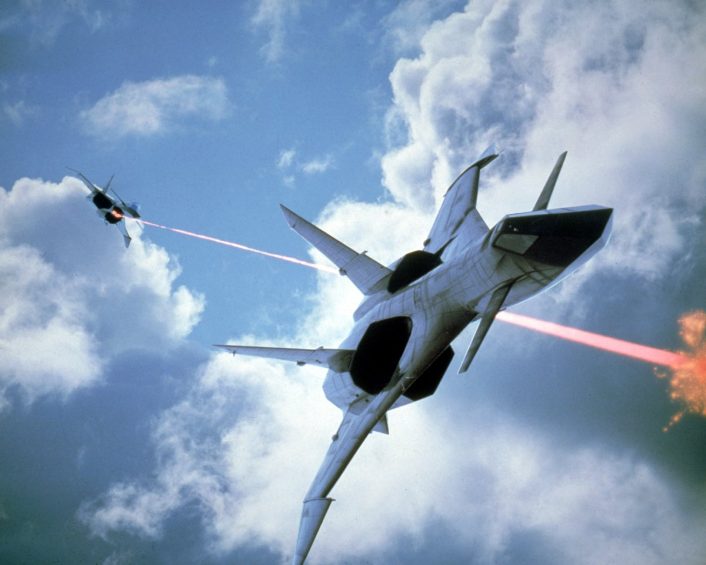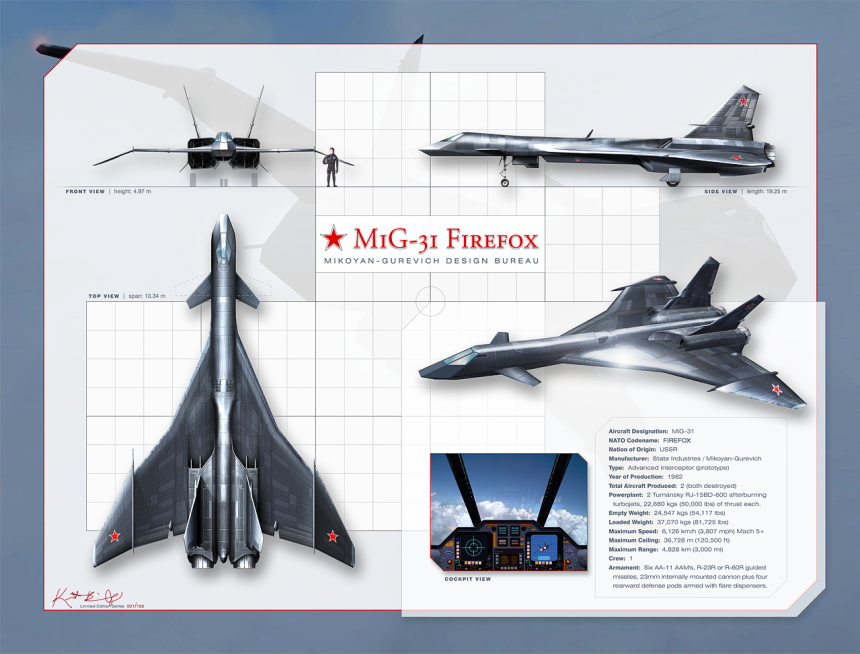If you thought you knew everything about the MiG-31, you were wrong!
Based upon a 1977 novel of the same name by Craig Thomas, “Firefox” is a techno-thriller action film produced, directed by and starring Clint Eastwood, released in 1982.
Most (if not all) the aviation geeks have probably seen the movie at least once.
The movie focuses on a plot to steal a Soviet MiG-31 (МиГ-31 in Cyrillic script), NATO reporting name “Firefox”, a stealth interceptor aircraft, capable of Mach 6 and bring it back to a friendly base where it can be analysed.
The shape of the Firefox differs a lot between the first novel and film. The version in the novel resembles a MiG-25 “Foxbat”, much like the real Mikoyan MiG-31 “Foxhound”. The movie version is a more futuristic design, unlike any other planes of the 1970s or 1980s. Indeed, the aircraft seems to have been influenced by the speculation about what the soon-to-be-revealed “stealth fighter” might have looked like.
Although the whole story is hardly plausible, what’s really interesting about the movie is the MiG-31 and some of its capabilities (some of those were not available at the time the novel was written or the movie released, but became available in the following decades): along with its ability to evade enemy radars and fly at hypersonic speeds, the Firefox featured a Thought-Controlled Weapons System, uses signals from the pilot’s brain to target enemies and fire weapons; however, it only responds to commands thought in Russian. The aircraft was fitted with a camera system that allowed the pilot to see images from his “6 o’clock”.
Two prototypes of the MiG-31 were built (according to the fictional story). The first prototype was stolen by Major Mitchell Gant (Clint Eastwood) who evades the Soviets’ attempts to stop him, reaches the Arctic ice pack where it lands to be refueled and rearmed by the crew of a submarine. The second prototype is launched to intercept the stolen Firefox. The subsequent, long dogfight is (needless to say) won by Gant.
A second novel was written by Craig Thomas in 1983. “Firefox Down” did not become a feature film even though the cover of book depicts the MiG-31 as it was in the movie.

Graphic designer Kurt Beswick (who has also illustrated the Northrop Low Altitude Penetrator concept for our site) has been researching and studying the aircraft featured in the 1982. He has also launched a website that acts as an online resource of information about the Firefox and its special effects.
Kurt has also produced a technical “whitepaper” to accompany the illustration that you can find at the top of this article. “Note that it’s all pulled from the movie and/or made-up by me and not meant to be taken seriously, it’s just for fun. Obviously a plane of this design and configuration wouldn’t be hypersonic, but for the sake of the film (and book) I keep it accurate to the details,” he wrote in an email.
Here below you can find some of the most interesting parts of the whitepaper.
BACKGROUND INFORMATION
The fundamental purpose behind the MiG-31 Firefox program was to develop an aircraft capable of intercepting anything the West currently had, which at that time were Lockheed’s SR-71 Blackbird, U-2B, TR-1, and the D-21 drone. The cold war was still at its peak and the need to “keep the other guy honest” led the United States to begin overflights of Russia with spyplanes. Thus, the Mach 3.5 Lockheed D-21 drone that launched from a “mothership” SR-71 was the only real concern Russia had in 1982. The Americans already had several successful launches and recoveries of the unmanned aircraft above 100,000 feet, Mikoyan-Gurevich needed to make this their primary target. Much of what they had learned from the MiG-25 Foxbat programme was applied to create one of the most advanced aircraft to ever take to the skies. The Firefox was at the forefront of aviation technology and the United States recognized this.
The MiG-31 budget kept getting larger and the hopes of building more than two prototypes quickly began to diminish. The titanium manufacturing process alone was already far beyond the initial budget for the program, but officials pushed forward regardless. They were not to be outdone by anyone, and they most certainly would not allow the American’s to overfly their aispace unchallenged any longer. Firefox was designed to be the ultimate high-speed, high-altitude interceptor.
POWERPLANT
The Firefox used a pair of Tumansky RJ-15BD-600 high-bypass afterburning turbojets capable of producing 50,000 lbs. thrust each. These were heavily modified, uprated turbojets based upon the engines from the MiG-25 Foxbat programme. Russian engineers took what they learned from high-mach turbojet engine technology and applied acquired US engine manufacturing technology to the Tumansky 600 series engines, built within the same footprint of the current R-15BD-300 design. The introduction of high-bypass air intake systems helped produce the most powerful conventional turbojet engine of its day, surpassing even the US built 32,000lb P&W J58, used in the much revered SR-71 Blackbird.
In addition to these massive engines, the Firefox had six Soyuz/Komarov solid rocket boosters, using a solid-propellant with a proprietary ignition/shutoff system. These rockets could be used to augment the main engines, providing an additional 15,900 pounds of thrust. These were normally used during take-off under full load or high-speed dash acceleration. In some rare cases, test pilots were known to engage these rockets at extreme altitudes where thin air produced flame-outs on the main engines. The first flying prototype was taken to 131,079 feet setting a new world record, breaking the previous record of 123,492 ft. held by a Ye-266M.
The compressor blade components were manufactured of pure titanium, a first for Russian aircraft manufacturing. Fuel was cooled via the centerline ventral air intake and then pumped through a complex series of conduits around the giant Tumansky engines to keep them cool, as well as throughout much of the airframe. Much of this technology and ideology was gleaned from information obtained by Russian agents on the production of the SR-71 Blackbird, which used similar cooling principles.
By alternating wastegate control between the dorsal and ventral air intakes using ramps, thereby more accurately controlling the engine-breathing, the RJ-15BD-600 could achieve incredible thrust to weight ratio and excellent high-altitude air-breathing qualities. Achieving Mach 6 was possible, although this was considered ‘maximum’ speed which was ineffecient to maintain for any period of time due to the MiG’s massive fuel consumption. Cruise speeds were more in the range of Mach 3.8 to 4.8, and operational altitudes under normal conditions were considered to be in the range of 95,000 to 105,000 feet.

AIRFRAME
The airframe was composed mostly of titanium and SS-118, a stainless steel/nickel alloy that was used extensively in the later model Foxbats. The MiG-31 was the first Soviet aircraft to extensively use titanium in the structure, it wasn’t until the mid 1970’s that Russian manufacturing technology reached a point where working extensively with titanium was actually realistic. However, with the addition of a radar absorbent material coating the aircraft, surface heating became a major problem.
To partially combat this issue the plane was designed with a very thin aspect-ratio to the leading/trailing edges of the wings, much like the Lockheed F-104 Starfighter. The nose and engine nacelles were designed based upon seamless flat-angles to minimize air friction and reduce overall drag. All rivets were countersunk, unlike most Russian aircraft preceding it, and there were virtually no exposed protuberances, sensors or seams anywhere on the craft. Expansion joints were built into the wings of the aircraft to allow for expansion/contraction of the skin due to this surface heating. The weapons bays were internal and missiles were carried on retractable launching racks behind flush-mounted doors on the port and starboard sides of the plane. Many different methods of heat-reduction were tested, but in the end the airframe was still a giant heatsink, not unlike its MiG-25 forefather.
The airframe had “stealth” characteristics, however there was much debate over the need for this considering the speed and altitude capabilities of the aircraft. It used a three-fold combination of countermeasures to make itself virtually undetectable to enemy radar systems. The design of the aircraft was angular enough to deflect much of the incoming radar away from its point of origin, the most basic form of “stealth” technology. In addition to this, the skin of the craft was coated with a radar absorbent material (RAM) very similar to American Stealth technology at the time. Finally, the MiG had electronic countermeasures (ECM) that could jam enemy early-warning systems. However, there was no way to effectively cool the exhaust of the giant Tumansky engines which gave the MiG-31 a massive heat signature for heatseeking missiles, which was considered one of the aircraft’s only major weaknesses.
AVIONICS SYSTEMS
The Firefox was the first aircraft to effectively use an operational thought-controlled weapons management system. Not only was it a fully operational and working system, it was also rather simple and unobtrusive from a mechanical standpoint. The receptors were mounted inside the specially designed helmet and linked to the aircraft’s central computer system via a fiber datalink. The pilot simply had to think (in Russian) about what weapon he wanted selected and could execute the command to launch the missile mentally. This is what is known as an EEG Feedback system. The pilot did not fly the aircraft via thought, he only controlled the weapons systems by thought. Most of the fly-by-wire systems in the aircraft were considered new technology at the time, but the Thought Controlled Weapons Management System was truly revolutionary. Mikoyan-Gurevich also managed to develop a synthetic aperture radar system for the plane which gave it even more mission flexibility, including being well suited for recon missions.

FATE OF THE FOX
I didn’t really follow the timeline of the Firefox novel according to Craig Thomas, because quite frankly I thought it was ridiculous to go through all of that effort to steal the plane only to crash it into the ground (as in “Firefox Down”). I instead took a few liberties with it, but still kept in line with the known facts. IE: The full-scale mockup of the Firefox really was filmed in and around a hangar at Edwards Air Force Base. So what I did was create a bit of a “history” for the aircraft. I thought to myself; ‘If this were an actual stolen Soviet fighter, where would the US military brass go with it?’ The first logical choice, since the plane was headed toward Alaska at the end of the movie, would be a secure facility in Northern California, probably Beale AFB since it has vast support capabilities and it’s fairly remote (they operated SR-71 and TR-1 spyplanes out of the base for years). Here, the majority of the initial inspection and study of the aircraft would be done. From there they would probably take it to Groom Lake to join the “Red Hat” squadron that consists of other acquired Russian military hardware.
Once the majority of the plane had been disassembled and reverse engineered over a period of several years, it would eventually find its way to the Dryden Flight Research Center at Edwards AFB in southern California. There, it would spend the rest of its life undergoing high-speed flight testing and metallurgy research in conjunction with their already-existing SR-71 testbed programme, not to mention study of the thought controlled weapons system. The possibilities are endless from there, perhaps the F-22 Raptor program would have had quite a different outcome had any of this actually been real.
CONCLUSION
The Mikoyan-Gurevich Design Bureau succeeded in creating an aircraft with capabilities far beyond anything the west currently had by using the proven “brute force” design tactic so typical of Russian military aircraft. The creative minds at the Mikoyan-Gurevich design bureau learned as much about what was being done at the time as they could, then improved upon the concepts in many ways. The west recognized this as an opportunity to even the table and consequently made the radical decision to steal the aircraft from Russia. They succeeded in doing so, succeeding also in destroying the only other prototype example of the MiG-31.
With both aircraft gone, all of the program funding used to build the first two prototypes gone, and several of their lead engineers killed in the process, Mikoyan-Gurevich decided not to reinstate the Firefox program. This effectively ended the legacy of one of the greatest, most powerful and technologically advanced aircraft of our time. There have been many stories about how the Firefox was never spoken of again within the corridors at Mikoyan-Gurevich. All records of it, along with the tooling, were destroyed shortly after it was stolen and there exists no mention of the programme in any Russian aviation literature. It was viewed by many top Russian officials as an embarrassing end to such an incredible machine.
Illustration by Kurt Beswick. Be sure to visit his website for tons of details about the MiG-31









